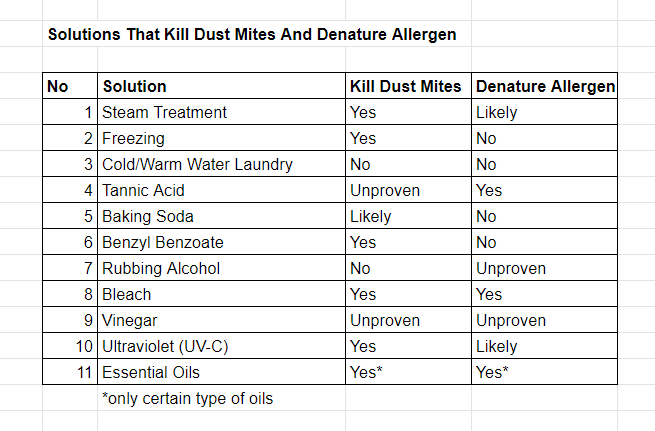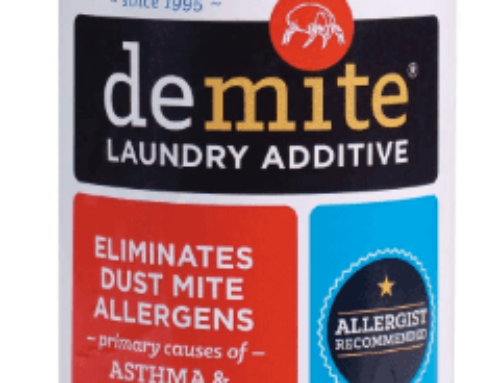Table of Contents
Stopping dust mite allergies is painfully hard. It can also be an expensive affair as you’ve read how getting tools like HEPA vacuum, steam cleaner, or UV sanitizer help to kill the mites. While some of these tools or methods may destroy the mites, some people show no reduction in the allergies.
The truth is, merely killing dust mites may not be enough to stop the allergies. It may seem mysterious why solutions like freezing stuffed toys have little to show in terms of allergy reduction.
Dust Mites vs. Dust Mite Allergen
You need to be aware that it wasn’t the mites that are directly triggering an allergic response in the human body. Instead, it was the proteins that are commonly found in the mites’ excretion, which causes allergy symptoms.
Some of the common allergy-inducing proteins in dust mite excretions are Der f 1 and Der p 1. When humans inhale dust mite allergens, these proteins come into contact with the respiratory system and thus trigger the allergies.
Therefore, the key to reducing or stopping the allergies goes beyond killing dust mites. While it’s important to reduce the dust mites population, you’ll need to denature or deactivate the remaining allergens to reduce the allergies.
Another fact that you need to know is that dust mite allergen or the fecal pellet measures around 20 microns. It is more than 10 times smaller than a dust mite, which is around 300 micron. If you’re dust mite cover with a pore size between 20 to 300 micron, you’ll still come into contact with the allergen in the mattress or pillow.
Do These Solutions Kill Dust Mites And Denature The Allergen?

Your bid in stopping dust mites allergies will be more effective when understanding if the action or tool that you’re using is effective in killing the mites and denaturing the allergen. I’ve dug into scientific studies for each item listed below.
1. Steam Treatment
It is an accepted fact that steam produced at high temperatures (>131F) is effective in killing dust mites and denaturing the allergen. However, a study has found that while steam treatment effectively kills dust mites in carpets, it is barely effective in denaturing the allergen. The study also mentions that the efficacy of steam vapor for dust mites and the allergen is only at its highest in the lab environment.
Yet, another clinical trial has shown that steam treatment has been very effective in reducing dust mite allergen in carpets. The result is also backed up by a separate study where 100% mortality of mites and denaturing of the allergen were observed.
Do the conflicting results mean you should stop steam cleaning the carpet? No.
Instead, you’ll want to combine steam cleaning with vacuuming with a HEPA vacuum. A study published in 2008 has shown that combining both methods remove 85.5% of dust mite allergen in carpets.
If denaturing the allergen in the carpet is difficult, you’ll just have to remove them safely.
Verdict
- Kill Dust Mites: Yes
- Denature Allergen: Likely
2. Freezing
You may have heard how freezing soft toys and other infested items will kill dust mites. While it’s true that dust mites can’t survive at low temperatures, freezing is unlikely to denature the allergen. According to this study, you’ll still need to wash the items to remove the allergen after freezing.
Verdict
- Kill Dust Mites: Yes
- Denature Allergen: No.
3. Laundry With Cold/Warm Water
When you wash clothing or bedding with cold or warm water, neither the dust mites will be killed nor the allergen denatured. However, there’s a chance that most of the mites and allergen will be removed.
A study has shown that up to 83% of live mites and 84% of the allergen could be removed when washing with warm water (36°C-38°C) or cold water(22°C-27°C).
How do you get a 100% kill rate? Well, wash in high temperature above 100% or use special detergents that kill dust mites and denature the allergens.
Verdict
- Kill Dust Mites: No
- Denature Allergen: No
4. Tannic Acid
Tannic acid, which is used in medications, food, and wood-staining. A detailed study has found tannic acid, introduced in 1% and 3% solutions, has been effective in denaturing dust mite allergen. However, no studies have suggested that tannic acid is effective in killing live mites.
You’ll want to be careful when using tannic acid. Researchers have cautioned that it deteriorates into microparticles, which may cause respiratory or skin problems.
Verdict
- Kill Dust Mites: Unproven
- Denature Allergen: Yes.
5. Baking Soda
Baking soda is a popular household item that’s often used in baking and cleaning. While there isn’t any study in its efficacy in killing dust mites, it is believed that baking soda absorbs moisture when coming into contact with live mites, thus killing the pests.
However, a study has been done on the effect of baking soda and the level of dust mite allergen. The result has been disappointing as there isn’t any reduction after baking soda is applied.
Verdict
- Kill Dust Mites: Likely
- Denature Allergen: No
6. Benzyl Benzoate
Commonly used in repellant and medicine, benzyl benzoate has been proven to be very effective in killing dust mite. According to a published study, all of the 50 live mites cultured are killed with a 0.8% solution of benzyl benzoate.
However, benzyl benzoate is not effective in denaturing the mites allergen, based on the same study for the baking soda.
Verdict
- Kill Dust Mites: Yes
- Denature Allergen: No
7. Rubbing Alcohol
There are no studies that suggest rubbing alcohol kill dust mites. Instead, there’s a video that shows that rubbing alcohol has absolutely no effect on dust mites.
As for denaturing dust mite allergen, there aren’t supporting scientific evidence available.
Verdict
- Kill Dust Mites: No
- Denature Allergen: Unproven
8. Bleach
Bleach has been a useful cleaning agent, particularly for stubborn stains. Researchers found that exposing dust mites to 10% of bleach solution effectively kill every single of them.
There’s also a strong suggestion from previous studies that link bleach to denaturing dust mite allergen. However, bleach isn’t recommended as a long term solution for dust mites, as over-exposure may link to complications like bronchitis and asthma.
Verdict
- Kill Dust Mites: Yes
- Denature Allergen: Yes
9. Vinegar
Vinegar is a popular household solution for cleaning, but does it kill dust mites? So far, no studies have been conducted to verify the popular myth of using vinegar to kill dust mites.
As for denaturing the allergen, the is a theory that the acidity of vinegar may neutralize the protein in the fecal pellets. Still, there isn’t any concrete evidence to back up the theory.
Verdict
- Kill Dust Mites: Unproven
- Denature Allergen: Unproven
10. Ultraviolet (UV-C)
The use of UV-C in killing dust mites is increasingly popular. Partly, is due to this report that proves the efficacy of UV-C in killing dust mites. However, it must be noted that the exposure duration and distance from the UV-C bulb increase the likelihood of the mites being killed.
UV-C may also alter the protein in the fecal pellets, which means there’s a chance that UV-C may denature the allergen.
Verdict
- Kill Dust Mites: Yes
- Denature Allergen: Likely
11. Essential Oils
Some essential oils, particularly clove, osemary, and eucalyptus are proven to be very effective in killing dust mites. This due to certain compounds like p-cymene and thymol, which are found to be in higher concentration in these essential oils.
However, to denature the allergen, you’ll need essential oils with high amount of limonene, according to a patent filed on methods of deactivating dust mite allergen. Essential oils with high level of limonene are cajeput, lemongrass, and caraway.
Verdict
- Kill Dust Mites: Yes (certain oils)
- Denature Allergen: Yes (certain oils)
Bottom Line
I hope you’ll find the answer to why the allergies linger even when you’re sure you’ve killed thousands of mites. Often, a combination of a few methods is needed to effectively kill the mites and reduce the allergy symptoms.




So the bottom line is essential oils is the only effective solution against both. How do I identify which one is around me? Is there any method to identify?
Hi Prav,
Essential oils are effective, but you’ll still need to choose the right one. If you have dust mites in your home, you’ll also have the allergen. The only way to really identify the mites or allergen is to get a test kit. Hope it helps.
Kenny
Hi Kenny,
I suffer from dust mite allergy. But funnily no information were given to me to manage it apart from just the diagnosis.
Your post explains the allergy symptoms really well and the natural solutions of killing the allergens.
I shall give them a go.
Many thanks
Habib
Hi Habib,
Glad to be helpful.
Kenny
Hi there!
This is a great article! Straight to the point and lost of useful tips! Thanks for sharing!
Hi Michael,
Glad to be helpful.
Kenny
Essential Oil use.
Can I mix 2 of the essential oils (killing & denaturing)?
What is the dosage and how is it applied? e.g. I have been using 30 drops off Tea Tree Oil to 32 oz. of Distilled water in a squirt bottle. I apply it to my mattress and when dusting bookshelves, etc. I’ve had limited success but would like to try using Eucalyptus and Lemongrass.
Hi Connie,
No problems in mixing the essential oils. 30 drops are enough. Do note that essential is not 100% lethal, which means it takes a longer time and needs to be applied repeatedly.
Kenny
Something we don’t ever think about is our home environment.
As clean as you may think it is under microscope will highlight a disturbing picture.
Enlarged those creatures are like something from another planet and frightening to think they are crawling all over us.
Great that you have highlighted what works and what doesn’t. I certainly will be looking into this in more details.
Thanks for sharing
Hi Mick,
Glad that you found the guide useful.
Thanks.
Kenny